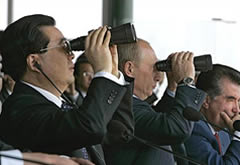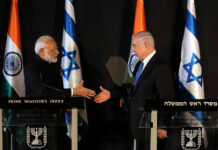No matter what experts may say, Russia’s growing assertiveness is already causing jitters in the West. The Shanghai Cooperation Organization (SCO), consisting of Russia, China and four Central Asian republics (Kazakhstan, Kyrgyzstan, Tajikistan and Uzbekistan), held its “Peace Mission 2007” joint war exercises in August, starting in the Chinese western province of Xinjiang and continuing it in Russia’s Ural region of Chelyabinsk. The military exercise, which followed the SCO’s annual summit in Kyrgyzstan earlier this month, represents a clear demonstration of the rising power tensions over the energy-rich Central Asian region.
If not enough to poke a finger in US President George Walker Bush’s eye, Russian president Vladimir Putin took the opportunity to formally announce that Russia was restoring the ancient Cold War practice of long-range patrolling by nuclear-capable strategic bombers around the world. In fact, with Russia’s nuclear bombers are now permanently airborne again and President Vladimir Putin loses no opportunity to strut the world stage and flex his country’s military muscles. While the bombers did not pose any acute danger, Russian planes are old and perhaps not sufficiently maintained for prolonged operational sorties. Their crews, both pilots and ground crews are not as well trained and professionally proficient as in Soviet times. This creates a distinct possibility that before long there will be dangerous accidents.
Yet all the sound and fury can hardly disguise an essential fact: that far from being a rising power like China or India, Russia is already locked in a long-term decline. While at present, the high global oil prices give Russia’s economy a temporary upsurge, with which Mr Putin can afford the necessary cash to display his military prowess- this may rapidly change, once oil prices decline again.
The age-old Achilles Heel is in Russia’s national economy. Its near total dependence on oil and natural gas, is both dangerous and prone to political adventurism. To illustrate this, Russia’s official GDP is approximately a mere$1.723 trillion compared to the huge US- $13 trillion! ( 2006 estimates). Moreover, While Mr Putin’s sabre rattling raises new memories of the Cold War, today’s overall strategic military situation does not even compare in the slightest with the Iron Curtain era.
In those days, until the late Eighties, Central Europe was a Russian fiefdom with Kremlin deploying no less than 18 armored divisions in the East Germany, projecting its military power toward the geographical centre of Europe. But today, by contrast, the former Soviet satellite states are fully independent and far from friendly to their former Kremlin mentors. Latvia, Estonia and Lithuania, once republics of the Soviet Union, are members of both the EU and NATO, which eastern border is now only a short drive from St Petersburg, one of Russia’s most prestigious strongholds. These fundamental realities vividly betray Russia’s essential strategic weakness.
Thus, Kremlin is trying to create a new strategic entity in Central Asia, where it believes that the United States, still embroiled in its Iraqi quagmire, is losing its former influence. The August military exercises are primarily meant to establish this image, but does it really impress those at which it is intended? It seems logical that the powers at be in Beijing will hardly throw in their lot with Putin’s dangerous ambitions, which will certainly place them at loggerheads with Bush’s strategic interests in South East Asia, before China becomes a real strategic regional power by itself.

But meanwhile the Russian military are not losing time to announce their new toys. Admiral Vladimir Masorin commander of the Russian Navy since 2005, said recently that Russia would resume building aircraft carriers in order to become a first-class naval power with a powerful ocean-going navy. But even Russian military analysts are refuting this kind of swaggering talk. Russian admirals have been pointing to a renewal of Moscow’s naval presence in the Mediterranean Sea, dominated by the US Sixth Fleet and NATO (CINCUSNAVEUR) since the cold war era. Unofficial Russian sourced estimates speak of one carrier, five cruisers (two nuclear-powered), nine destroyers, and 12 ocean-going frigates which are considered to be operational, but naval experts estimate even these figures over optimistic. With such a small force already dispersed among four different naval commands, (Black, North, Baltic Sea and the Pacific Ocean fleets), it will be far from easy “to restore” a combat effective task force in the Mediterranean on “a permanent basis.”
In the communist era Russia had built five aircraft carriers, all constructed at a shipyard in Nikolayev, Ukraine This shipyard is today politically unavailable to Russia and another option seems not in sight at the moment for the monumental task, which Admiral Masorin insinuates. According to naval experts, Russia simply cannot build a carrier, since it does not have a shipyard with a dock that can construct ships of such size. Moreover, of the five carriers in Soviet era arsenals, three of them have already been sold abroad as scrap. The only one retained by the Russian Navy, the Admiral Kuznetsov, which has turned out to be an inoperable wreck. Another embarrassing story concerns the fate of Russia’s attempt to modernize the Class (Type 1143.5) Heavy Aircraft Carrying Cruiser Gorshkov. The $1.5 billion contract to modernize the Class (Type 1143.5) Heavy Aircraft Carrying Cruiser Gorshkov was signed in 2004, and the Indian Navy was hoping to get a fully operational carrier in 2008, complete with an air wing of MiG-29K jet fighters. In August this year, it was reported that the Sevmash Shipyards at Severodvinsk, in northern Russia, was unable to complete the Gorshkov on time and construction will not conclude before 2011! Sevmash Director General Vladimir Pastukhov was fired by the Kremlin for this debacle.
New and powerful missiles are part of a significant plan beefing up most of Russia’s decadent weapons systems. The Bulava missile system will become a flagship project that Russian President Vladimir Putin has claimed piercing any Western missile shield. The decision to go ahead with production despite several test failures comes in the wake of a US-Russia concern over American plans to base 10 missile interceptors in Poland and radar installations in the Czech Republic, which the Russian president regards as a personal affront.
But that is not all. Russia’s former pride in its fleet of missile submarines, has been reduced to a mere nine vessels. Although the first Russian fourth-generation strategic nuclear submarine the Project 955 or Borey -class Yury Dolgoruky, was launched during a special ceremony at a shipbuilding yard in northern Russia last April, the Navy has still not quite overcome the highly publicized and painful loss of the K-141 Kursk in August 2000.
According to Alexander Buturin, a presidential advisor on military-technical policy, Russia will invest about 170 billion rubles ($6,5bln) in the next eight to 10 years, in modernization of its shipyards. But while quite impressive, under present Russian economic conditions, this somewhat meager funding in global comparisons, would be totally insufficient to create a naval force of size and power, capable in confronting modern western naval forces already in service. In fact, with the bulk of the money, some 13 billion rubles, already earmarked for the construction of three Project 955 submarines would leave little or nothing for the Russian Navy’s urgent technical equipment program modernization.
According to intelligence reports, the Russian strategic bomber fleet currently has operational aircraft stationed only at two major airbases, and the absence of an effective modern early warning system leaves the Russian aircraft almost completely vulnerable to a surprise attack. The same applies to the mobile launchers for Topol-M intercontinental ballistic missiles, which now hardly ever leave their hangars — hangars which the Americans have constantly in their sights. In comparison, as of the beginning of the year, Russia had only 79 strategic bombers, according to data exchanged with the United States under the START I arms control treaty. At the peak of the Cold War, the Soviet long-range bomber fleet numbered several hundred. Even under the most optimistic conditions, money being no object, it might well take years until such a level of operational bomber fleet will become a real threat to western strategic air domination.
As for Russia’s defense industry, the situation is not much better, if one glimpses behind the bombastic public relations stunts in air-and defense shows. None other than Lieutenant General Sergey Chemezov, head of Rosoboronexport, the Russian state defense export agency, recently painted a dramatic picture of the dismal state of his country’s weapons industry. The majority of weapons manufacturers, says Chemezov, a close confidante of President Putin, are in a “difficult situation,” with 75 percent of their production facilities obsolete. According to one study, one-third of Russia’s arms manufacturers are “virtually bankrupt.”
According to analysts in the know, although the Russian defense budget has almost quadrupled to its current level of $31 billion in the last six years, Kremlin uses its military spending “very ineffectively” when it comes to upgrading its equipment, says arms expert Ruslan Puchov. And, based on a study by GRU, the Russian military intelligence agency, about one-third of the country’s military budget ends up lining the pockets of high-ranking officers and party bosses.
In comparison, US military spending is in a different league altogether. Since taking office in January 2001, US President George W. Bush has almost doubled the Pentagon budget. Russian Defense Minister Sergey Ivanov complained that the US defense budget is “25 times as large as Russia’s.” Just to name a single item, the US Navy plans to commission its 13th aircraft carrier very shortly! And even for a limited and still highly controversial ad-hoc project like MRAP, the Pentagon received immediate funding for over $ 20 billion, without a blink of the eye from Congress. Under such circumstances it seems highly unlikely that Moscow could, in the foreseen future, catch up with the United States technologically. Instead, the purpose of the planned modernization effort is probably aimed to polish the image of the Russian state and its decrepit military, not just domestically but mainly among allies and potential clients in the Middle East.
Moscow simply lacks the financial means to effectively challenge the Americans. “Russia’s gross domestic product is only one-thirteenth of that of the United States,” says Vladimir Ryzhkov, a member of the opposition in Russia’s parliament, who regards Putin’s aggressive rhetoric as an effort to impress Russian voters leading up to oncoming December parliamentary elections. The latest publicity stunt by Moscow in its dramatic submarine dive to plant the Russian flag on the seabed at the North Pole last week may have rattled Canadian politics and underscored the growing stakes as the ice cap melts in the oil-rich Arctic, but was primarily intended for local consumption. Sending some of its strategic bomber fleet flying above the North Pole only enhanced Putin’s display of Russia’s military muscle to the media.
Taking at its facts, there is no doubt Putin’s Russia has come a long way from the remnants of a crumbling empire that Yeltsin inherited and ran into the ground. And the timing of the renaissance – when superpower concerns are drowning in self-created war-against-terrorism quagmires – has been near perfect. Indeed, Putin’s Cold War reminiscent response to America’s missile defence system in Europe exposes the West’s growing limits and frustration at a come-again Russia.
oscow’s decision to resume Cold War-style strategic bomber patrols confirms it has revived the political will and economic means to challenge US global dominance and NATO expansion with more than just rhetoric. Wether this strategy succeeds remains highly doubtful, however.

Indeed, Putin’s gambit may well backfire on his strategic ambitions. With next year’s US presidential elections looming near, the Republicans, based on present lack of public support, may lose, which will enter a Democratic president into the White House. But if Putin’s provocations persist and emerge into a real cold war scenario arms race, it will not only jeopardize the democrat chances, but most probably retain a hard-line republican like John McCain, to “save America” from the “Bad Russian Bear”. Vladimir Putin has already been regarded as Washington’s “bad guy”. Secretary of State Condoleezza Rice has never trusted Putin, being a former KGB agent, and influential Senator McCain has been persistently calling for a tougher stance on Moscow for years. Moreover, the US economy will surely benefit and flourish further, when its heavy industry once again receives top national priorities to win another inter-global arms race. This can hardly be Putin’s aim, but perhaps the clocks in Moscow go different than in Washington?
















